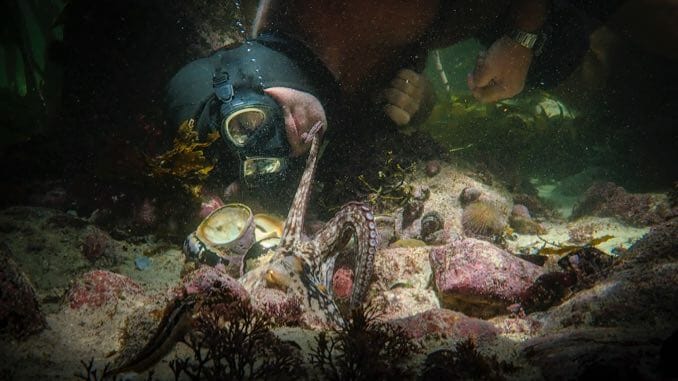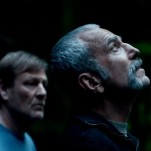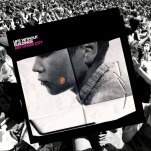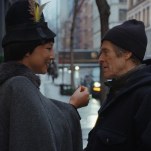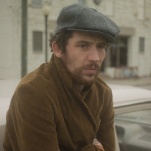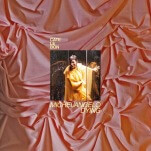So many of best documentaries on Netflix are now Netflix Originals. While the selection of docs available on Netflix isn’t what it used to be, the streaming giant has still provided groundbreaking and important documentaries a much broader audience, be it semi-obscure essentials like Casting JonBenet and Shirkers; festival finds like Crip Camp and Mucho Mucho Amor; Oscar-nominated originals like Strong Island and The Edge of Democracy; or titillating true-crime docs like The Tinder Swindler. If you’re looking to find new, compelling stories, there are plenty to peruse here, but browsing the documentary section of Netflix also might convince you that documentary movies didn’t exist before 1990.
In his films, Robert Greene has tried to bring the alienated past into the present. Kate Plays Christine, from 2016, uses Kate Lyn Sheil’s preparation to play Christine Chubbuck—the newscaster who died by suicide on air 42 years earlier—in part to navigate an actor’s responsibilities when trying to resurrect a real person relegated to folklore. 2018’s Bisbee ’17 chronicled the reenactment, on the event’s 100th anniversary, of the forced removal and abandonment of more than 1,200 striking miners from their homes into the Arizona desert. As Bisbee community members take on the roles of both deputized corporate thugs and workers demanding better lives, in many cases inhabiting the personas of their own ancestors, they come to better understand the sway such history still holds over today. Even in Actress, Greene’s 2014 portrait of Brandy Burre returning to acting as she reinvents her personal life, re-evaluating the past is an act of taking control. When Burre slowly goes back on stage, engaging with old friends and with the visceral excitement of being in front of an audience, she begins to steer her life away from a toxic marriage and define herself anew. She realizes she’s no longer obligated to hold on to her old self. Procession, Greene’s latest film and his first for Netflix, is again about acquitting the present from the past. It begins with a 2018 press conference in Kansas City, Missouri. Lawyer Rebecca Randles stands with three of the survivors stating that they can call out more than 230 known Catholic clergy members in the Kansas City area part of a far-reaching network of sexual abuse. Seeing this, Greene reached out to Randles with the idea to use drama therapy, closely guided by registered drama therapist Monica Phinney, to give a small group of survivors the chance to transform their nightmares into something dramatic, to potentially transform their trauma into something survivable. Procession presents this approach: Six men scripting, storyboarding, location scouting and finally shooting their worst memories, however they want to interpret them, interspersed with the completed results. The young actor who stars in each of the segments, Terrick Trobough, spends much of the film in the company of the six survivors, hearing their stories and quietly, professionally doing his job. He witnesses them weep and punch things and disassociate, not because they’re fragile, but because they’re broken. Terrick responds that he believes their stories. Later, with Dan (one of the survivors) following an emotional moment, Terrick asks him, “How are you?” Maybe he’s just being polite, but Terrick’s small gestures of empathy glow brightly. As does Procession, when the beauty of Greene’s filmmaking satisfies the intelligence and clarity of his methods. “I hope the strength you showed is rewarded with peace and contentment,” another survivor tells himself near the end of the film, reaching decades into the past. A close-up of his face lets the audience know if that hope has been resolved. It’s very good kino.—Dom Sinacola
If every great documentary is about the responsibility of observation, then Kirsten Johnson’s Cameraperson is also about the fragility of that observation. With her follow-up, Dick Johnson Is Dead, Johnson continues to interrogate that fragility, crafting a deeply personal ode to that over which she has no control: her father’s death. It helps that Dick Johnson is a mellifluous soul, an incessantly warm and beaming man surrounded by friends and colleagues and acquaintances who all uniformly, genuinely love him, but from its opening shots, Johnson makes it clear that her father’s wonderful nature will only make saying goodbye to him that much more difficult. And the time when she must do so looms closer and closer. Her impetus, she reluctantly acknowledges, is partly selfish as she decides to help acquaint her father with the end of his life, reenacting in lavish cinematic vignettes the many ways in which he could go out, from falling air conditioner unit, to nail-festooned 2×4 to the face, to your run-of-the-mill tumble down the stairs, replete with broken neck. The more Johnson loses herself in the project, spending more effort consulting stunt people and art directors and assorted crew members than her own dad (sitting peacefully on set, usually napping, never being much of a bother), the more she realizes she may be exploiting someone she loves—someone who is beginning to show the alarming signs of dementia and can no longer fully grasp the high concept to which he once agreed—to assuage her own anxiety. As her dad’s memory dissipates along with his ability to take care of himself, Dick Johnson Is Dead caters less to Dick’s need to preserve some sense of immortality than to his daughter’s need, all of our need, to let go. —Dom Sinacola
Making sense of one’s past can be both a lifelong undertaking and a thorny proposition. In Shirkers, novelist Sandi Tan accomplishes that trickiest of endeavors, directing a documentary about herself that isn’t cloying or cringe-worthy. Quite the contrary, her movie is refreshingly candid and self-critical: She may be the star of the show, but she has a story to tell and the right perspective to frame it properly. Tan narrates the documentary as a memory piece, recounting her childhood in Singapore with her best friend Jasmine, where they were the two cool kids in their pretty square school, dreaming of being filmmakers and leaving their mark. To further that ambition, they collaborated with another friend, Sophia, on a surreal road movie called Shirkers, which would be directed by Tan’s mentor, an older teacher named Georges who carried himself as someone who knew his way around a movie camera. In her late teens and perhaps smitten with this man who showed her such attention—the documentary is cagey on the subject—Tan was intoxicated by the rush of making a film that she wrote and would be the star of. So how come we’ve never seen it? The documentary traces the strange, mysterious journey of the project, which was waylaid by Georges sneaking off with the reels of film with a vague promise of finishing the work. That never happened, and 20 years later Tan decides to open those old wounds, connecting with her old friends and trying to determine what became of Georges. Scenes from the unfinished film appear in Shirkers, tipping the audience off to the fact that there will be a happy-ish resolution to Tan’s quest. But the documentary ends up being less about tracking down the film canisters than being an exploration of nostalgia, friendship and the allure of mentors. Tan is lively, self-effacing company throughout—her voice has just the right sardonic tinge—but her visits with Jasmine and Sophia are particularly lovely and illuminating, suggesting how lifelong pals can see us in ways that we cannot. —Tim Grierson
Director Ava DuVernay has successfully made a documentary that challenges and even dismantles our collective understanding of one of the most dangerous notions of our time: “progress.” How do we define progress, and who precisely gets to define it? 13th is a captivating argument against those who measure progress with laws that pretend to protect American citizens and amendments, and even to uphold the Constitution. It is a deftly woven and defiant look at how clauses within those amendments (specifically the lauded 13th) and the language of our political system both veil and reveal a profound and devastating truth about America: Slavery was never abolished here, DuVernay and the participants in the film argue. It was simply amended, and it continues to be amended in 2016, with the constant evolution of the criminal justice system. It’s a bold and terrifying statement to make, but in using a documentary instead of, say, a narrative film, DuVernay is able to point directly to that history and to those people who have defined “progress” for black Americans. In doing so, she draws a line directly from the 13th amendment, to today’s America, which has the highest rate of incarceration in the world. Like some of the best documentaries of our time, 13th is not just a film, but a demand; it’s a call to reject dangerous reiterations, specifically newer and newer Jim Crows. DuVernay’s work doesn’t expressly name what we might build in their place, but it demands that those of us watching resist the seduction of sameness disguised as slow progress, and imagine something greater: actual freedom. —Shannon M. Houston
There seem to be two goals of Netflix’s new Michelle Obama documentary—first, to humanize (or normalize) the former First Lady of the United States as she embarks on a countrywide book tour (for her bestseller of the same name), and second, to reinforce the idea that Michelle Obama is a woman necessarily and eternally concerned with race and racism in America, particularly for Black women. The first goal is achieved, almost as much as it can be, and the personal stories and appearance of family members like her mother and brother are the strongest part of the Becoming experience. The second goal is a little more complicated, largely due to the fact that Michelle Obama occupies a strange space as a figure who is neither a politician, nor an activist—but who often presents like one or the other. Nadia Hallgren’s film is an attempt at a portrait of a lady seemingly on fire, now that she’s “free at last.” In an early scene, Obama and billionaire Oprah Winfrey laugh as they candidly discuss the relief that came with the end of her time in the White House. Becoming is about the “liberation” of Michelle Obama, and it takes care to remind us of all that she endured on the road to the White House. There’s a hollowness sometimes echoed in Obama’s celebrity interviews (on her press tour, she sits down with the likes of Oprah, Stephen Colbert, Gayle King and Reese Witherspoon), but something far more interesting happens when Obama is working as a mentor. In several scenes, she sits down with small groups—groups of Black women, young female students, Native American students in Arizona, and older black women in the church. In one especially compelling scene, we go home with Shayla, a teen in one of the groups, and we get to know the women who are inspired by Obama’s story of becoming. Watching a young black girl, giddy as she imitates the former First Lady’s walk down a hall, we get the sense that the mere experience of being in the same space as Obama will change some of these girls forever. They light up the screen in this documentary; they are the true stars, and they bring the real magic to this story. —Shannon M. Houston
Bob Dylan’s life and career are so encased in myth that it can be hard to untangle the romanticism from the reality. As much a symbol as he is a man, Dylan has spent most of his adulthood resisting being labeled the voice of his generation while slyly welcoming fans’ desire to dissect his every utterance, devoting much of the last couple decades opening up the vaults to release a series of official “bootleg” recordings associated with his most iconic albums and tours. He invites us to look deeper and listen harder, as if the answers can be gleaned from closer study. Long before David Bowie, Tom Waits, Madonna or Lady Gaga dabbled in persona play, Robert Zimmerman made us ponder masks in popular music. He’s both there and not there, which can be frustrating and fascinating. Both sensations are on display in Rolling Thunder Revue, the oft-spectacular, sometimes shtick-y chronicle of Dylan’s 1975 Rolling Thunder tour. As is typical when depicting anything in the Dylan universe, this concert film/documentary simultaneously oversells its subject’s genius and provides overwhelming evidence of what a brilliant artist he is. The documentary’s full title should also be a disclaimer: Rolling Thunder Revue: A Bob Dylan Story by Martin Scorsese. Early on, the movie features a contemporary interview from Dylan confessing that he doesn’t quite remember what prompted Rolling Thunder or what his ambitions were. “I don’t have a clue because it’s about nothing,” he says, another example of obscuration and seduction. The movie is a “story,” which means some parts might be invented or exaggerated, and because it’s “by Martin Scorsese,” the whole film is filtered through one artist’s perspective on another. Scorsese is after something grander than mere documentation—more layers of myth are applied while trying to present an honest account of a tour and a performer. At nearly two-and-a-half hours, Rolling Thunder Revue is overlong but also overpowering, inconclusive yet undeniably stirring. It left me exhausted, but I kinda want to see it again. —Tim Grierson
11. The SquareYear: 2013
Director: Jehane Noujaim
Rating: NR
Watch on Netflix
Bringing calm insight to an impassioned, still-developing historic event, The Square looks at the 2011 Egyptian Revolution from the perspective of those who were on the frontlines from the very beginning, personalizing the dramatic developments without losing a sense of greater stakes. Director Jehane Noujaim, who previously helmed Control Room and co-directed Startup.com, has delivered a snapshot of a grassroots political movement over its bumpy two-year history, embracing the emotional complexity and logistical obstacles that have made Egyptians’ road to democracy so difficult. Using no voiceover narration and only a handful of intertitles that inform the viewer about the exact time period of events, The Square seeks to create an urgent, immediate experience that tells its story through the reactions of its main participants. In the West, the scenes of peaceful, joyous protest at Tahrir Square were warmly greeted as hopeful signs of a new Middle East. The Square doesn’t throw cold water on those hopes as much as it meticulously demonstrates that systemic change does not come easily. That’s why you care so deeply about the people you see in this movie—it’s not that their quest is easy but that it’s so very hard. —Tim Grierson
12. They Shall Not Grow OldYear: 2023
Director: Peter Jackson
Rating: R
Watch on Netflix
Even documentaries are not entirely immune from the human desire to engage in mythmaking. We’re always looking for a narrative, in history and in our own lives when the truth is that a lot of things happen for inscrutable reasons and no person or society fits easily into a neat little box. The incredible achievement director Peter Jackson and his team of restorers have pulled off in They Shall Not Grow Old is making that sort of narrative seem so real that any skepticism you have about it is totally overwhelmed as you’re watching it. It’s an unqualified triumph of film restoration, possible only thanks to the century of technology that separates its subject from the final result. The documentary is built from the voices of World War I veterans reliving the conflict in their later years, cut over original video footage from the war provided by the UK’s Imperial War Museum to commemorate the centennial of the end of the war. The film completely eschews narration, letting voice recordings of the British soldiers who served at the front tell their stories with no chyrons and little more in the way of structure than beginning at their enlistment and ending with their stories of returning home. The first stretches of the film are in rough black and white, and for this stretch, while the old men are narrating their experiences at boot camp, it looks very much like something you’ve seen in class. The hat trick of changing over to the footage that’s been fully restored, colorized, surround sound-designed and rendered into 3D, is somehow a reverse Wizard of Oz: The grim realities of the trenches and the front are the part of the film being made to seem real in comparison to the drab safety of home. With the painstaking craft used to imbue color and sound and some semblance of reality to the footage of these long-dead men, They Shall Not Grow Old all of a sudden becomes one of the most urgent documentaries of recent years despite focusing on a subject a century after the fact. They Shall Not Grow Old is only telling one side of a complicated story. In this case, it’s being told in an unforgettable way. —Kenneth Lowe
13. HomecomingYear: 2019
Directors: Beyoncé Knowles-Carter, Ed Burke
Rating: NR
Watch on Netflix
Childish Gambino, Ariana Grande, Tame Impala: None of those performers, or any of the others at Coachella 2019, were able to match the grandiosity of Beychella, Beyoncé’s epic pair of sets at last year’s festival. Netflix’s Homecoming, a documentary written, produced and directed by Mrs. Knowles-Carter herself, features stunning footage of each weekend’s set and dives deep into the symbolism, production and eight-month rehearsal process behind Beychella. The film also arrived with a surprise live album encompassing the entire Coachella set as well as new music. It’s all just The Carters’ latest in a long line of masterpieces, a colossal, visually stunning spectacle that not only summarized Beyoncé’s 20-year career, but also Historic Black Colleges in an entirely new way. We see clips from football games at schools like Howard University and Alabama A&M interspersed with Beychella rehearsal footage, the entire performance and film a celebration of those institutions, perhaps even an antithesis to what most people would consider a primarily white experience. If you haven’t seen it yet, you might want to consider canceling your plans tonight: Bey deserves your full attention. —Ellen Johnson
14. My Octopus TeacherYear: 2020
Directors: Pippa Ehrlich, James Reed
Rating: TV-G
Runtime: 85 minutes
Watch on Netflix
My Octopus Teacher exists as a potent attempt to harmonize with the worldly and emotional perceptions of Craig Foster, a South African diver who forges a singularly strange and fascinating bond with an octopus following a plunge into lethargy. “I had to have a radical change,” Craig says about what was essentially his midlife crisis. So he returns to the waters where he spent so much of his childhood, charting a course for his life and for a documentary that’s just as much about the nature of human fascination as the oddities of nature. Foster’s empathetic understanding of the natural world as a place to completely invest oneself takes shape through his massive expenditures of time in the Atlantic Ocean’s depths. Some would (and do) refer to it as obsession, and it may very well be—the minimal involvement of Foster’s human family could be interpreted as prickly skepticism about his lengthy Atlantic sojourns, just as those sojourns are splendidly visualized. There are no news headline montages or data dumps in My Octopus Teacher about how human apathy continues to wreck Earth’s oceans, but it’s impossible not to reckon with it as we watch Foster diving through stunningly captured kelp forests and gliding on top of calm waters as if he were skimming across glistening gemstones. What makes the movie intriguing is that inherent juxtaposition between the grandiosity of one human’s connection and humanity’s disconnection—the time the lonely Foster takes to understand the environment he’s known since he was a child. Foster’s oceanic explorations are vivid to the point that we understand a part of our world that much better as well—his obsession is our education. In the movie’s final minutes, Foster waxes poetic about how he came to “sense how vulnerable these wild animals’ lives are, and, actually, how vulnerable all our lives on this planet are.” —David Lynch
15. Strong IslandYear: 2017
Director: Yance Ford
Rating: NR
Watch on Netflix
African American filmmaker Yance Ford’s Strong Island is a paean to his brother William, who was shot dead in 1992 by a white mechanic during an argument. The shooter never faced trial—it was ruled self-defense—and in the ensuing decades Ford and his family have wrestled with the injustice. Strong Island is Ford’s way of working through the pain and anger that still consume him, mixing interviews with direct addresses to the camera. It’s a slightly unfocused work (Can anyone fault Ford for being unable to marshal his grief into a completely organized treatise?) but its rawness fuels its astounding strength. —Tim Grierson
16. American FactoryYear: 2019
Directors: Steven Bognar, Julia Reichert
Rating: NR
Watch on Netflix
The plight of the American Rust Belt in the era of globalization, mechanized labor and outsourced jobs is real but, also, a media construct that’s been simplified into a talking point. For those not experiencing that reality on a daily basis, it can very easily become an abstraction. Steven Bognar and Julia Reichert’s American Factory sympathetically illustrates what those everyday pains look like, bringing us into the world of an Ohio automotive plant laid low by the 2008 recession. Several years after the factory closed, a Chinese company called Fuyao moved in, hiring back many of the employees of the old plant and offering hope to an economically depressed community. The American workers would help build windshields for cars and, ideally, along the way discover that Chinese and American employees can live together in harmony. Bognar and Reichert’s film chronicles how that wishful thinking collapsed, but this is not a simpleminded story in which we can grasp onto an easy rooting interest. While American Factory is certainly told more from the perspective of the Americans, there’s an evenhandedness to the filmmaking, which gives the material the sobering weight of grim inevitability. Early on, we can surmise that things may not work out: The Chinese bosses note derisively to their cohorts that the Americans have fat fingers, while the American workers feel alienated by motivational slogans put on the walls in fractured English. American Factory is a portrait of how two cultures clash—not violently or maliciously or even intentionally. Nonetheless, divisions start to form, and overriding financial interests take precedence over individuals, resulting in employment shakeups for both workforces. A documentary as bluntly titled as American Factory may suggest a definitive take on a large socioeconomic situation, but Bognar and Reichert’s film succeeds because it stays micro. Even their conclusions are measured, if also dispiriting. American Factory doesn’t suggest that China is the future—or that America is in decline—but, rather, just how much power corporations have in shaping society and dictating our fates. One of this film’s most crushing ironies is that its true villain is a faceless, insatiable desire for higher and higher profits. Every person we meet in American Factory is at that monster’s mercy. —Tim Grierson
17. The Trapped 13: How We Survived the Thai CaveYear: 2022
Director: Pailin Wedel
Rating: TV-14
Watch on Netflix
In the short time since 13 young boys on the Wild Boars soccer team became trapped in a flooded cave for 18 world-captivating days, there have been no shortage of film and TV adaptations of the incident. But not long after the incident took place, Netflix locked down exclusive rights to the boys’ stories, making it so every other take on the event—even Howard’s $55 million dollar endeavor—had to almost entirely circumvent any depiction of the victims. The Trapped 13: How We Survived the Thai Cave features exclusive testimony from six of the boys—Tee, Titan, Tle, Adul, Mark, Mix—and their coach, Eak. If nothing else, Trapped 13 emphasizes that, without a doubt, the most important perspectives in the story of the Tham Luang cave rescue are those of the boys. Their recollections of the event are consistently moving, funny and surprising. Instead of recalling any sense of impending doom as they first entered the cave’s mouth, for example, the boys giggle as they remember teasing one of their teammates for having a girlfriend. Later, when faced with near-lethal levels of starvation, they describe daydreaming that they were able to convince a delivery person to swim through the winding networks of the cavern to deliver them fresh baskets of crispy chicken. As heartbreaking as you expect the gory details of the boys’ time in the cave to be, they are a thousand times more so. It’s difficult not to catch a lump in your throat when Eak expresses a sense of responsibility for bringing them into the cave in the first place. But the compelling nature of Trapped 13 isn’t just a product of its raw, chilling testimonies. Wedel nearly perfects the tough balancing act that comes with constructing a documentary: Crafting something that is at once beautifully stylized, but doesn’t distract from the truth at hand. —Aurora Amidon
18. The Tinder SwindlerYear: 2022
Director: Felicity Morris
Rating: TV-MA
Watch on Netflix
In 2019, Norwegian newspaper VG published an article titled “The Tinder Swindler,” which sent shockwaves through the general public on par with The Atlantic’s “The Truth About Dentistry,” or the New York Times’ “Who is the Bad Art Friend?” The article follows a man named Shimon Hayut who spent years of his life posing as Simon Leviev, the heir to a behemoth Israeli diamond fortune. He adopted this persona to court women on Tinder and, once he has earned their trust, to trick them into loaning him hundreds of thousands of dollars—money he would then use to woo his next victim. As is the case with most popular IP, “The Tinder Swindler” was picked up for adaptation at lightning speed, and developed into a documentary by the masterminds behind Netflix’s Don’t Fuck with Cats, the deep-dive miniseries into the stranger-than-fiction story of the rise-and-fall of a porn-star-turned-cat-torturer-and-maybe-cannibal. Directed by Felicity Morris, The Tinder Swindler is not dissimilar to Don’t Fuck with Cats in that it is delightfully high-concept, bringing with it a similar frenetic energy and playful teasing out of twists. More than anything The Tinder Swindler has its finger on the pulse of what viewers want in a true crime documentary. At just under two hours, it doesn’t drag on longer than it needs to. It is short, snappy and succinct. It also effortlessly fits in everything we look for in a doc like this: A retelling of the crime and the investigation (the latter being, in this case, even more interesting than the former), non-distracting reenactments and an engaging tone, which Swindler accomplishes by whipping around the globe to exotic locations—all paired with a lively soundtrack. —Aurora Amidon
19. Miss AmericanaYear: 2020
Director: Lana Wilson
Rating: TV-MA
Watch on Netflix
I remember the first time I heard a Taylor Swift song, and if you’re also a millennial or Gen Z-er, chances are you do, too. I was 10, maybe 11, hanging at my friend Erin’s house, which was two doors down from mine. She whipped out a fluorescent blue iPod Nano before passing me an earbud and cranking up “Our Song. ” Taylor Swift is a tall memory in many of our childhoods. In Swift’s 2020 Netflix documentary Miss Americana, she recognizes, with an almost maternal gesture, this relationship to her listeners. “There is an element to my fan base where we feel like we grew up together,” Swift says about a few minutes into Lana Wilson’s excellent movie, streaming now on Netflix. “I’ll be going through something, write the album about it and then it’ll come out, and sometimes it’ll just coincide with what they’re going through, kind of like they’re reading my diary.” Swift’s diary has been broadcasted across the world for the better part of two decades, and that means normalcy has been hard to come by. Miss Americana doesn’t strain to convey the opposite. It’s not a “the-stars, they’re-just-like-us!” event. Throughout its 85 minutes, Swift is greeted by masses of screaming fans as she exits her NYC apartment, flies in a private jet with her mom and her giant Great Dane “Kitty” and is met with millions of lovers and haters in equal portions. Where the film really proves that Swift actually could be just like us is in her internal ethical struggles—and her innate desire to be liked by other people. These conflicts are just on a much grander scale than yours or mine. Swift’s drive for approval isn’t just a desire—it’s her livelihood. —Ellen Johnson
20. A Cop MovieYear: 2021
Director: Alonso Ruizpalacios
Rating: R
Watch on Netflix
Out of the many striking shots captured in the docu-fiction hybrid A Cop Movie, one conveys the essence of director Alonso Ruizpalacios’ examination of Mexico’s police force unlike any other. After tying her wrist to a long, flimsy piece of rope, police academy trainee Teresa prepares to jump off of a 30-foot diving platform and into a swimming pool. It is the last challenge she must overcome in order to graduate—that of “decisiveness”—but poses an enormous threat to her life as she cannot swim, her likely fate of drowning callously counteracted by keeping her wrist tethered to land. Interestingly, Teresa turns out to be less of a documentary subject and more of an avatar for Ruizpalacios to survey the civilian perspective of the country’s police force. Presented as the honest central subject for nearly half of the film, Teresa (who is based on a real person) turns out to be played by actress Monica del Carmen, who has expertly molded herself in the real-life officer’s image, reenacting memories from her days as an academy student to her most recent workplace woes patrolling the streets of Mexico City. At her side is fellow actor Raúl Briones, who portrays Montoya (also a real guy), the second half of the duo dubbed “the love patrol” by other cops due to their flirtatious relationship as partners. Though initially presenting themselves as two officers simply doing their best within a crumbling system, the second half of the film makes it clear that these sentiments are only the biased projections of their real-life counterparts. Through carefully crafting this illusion and then stealthily unveiling the hypocrisy behind it, A Cop Movie is subtle yet audacious in its indictment of police corruption and the individual officers who buy into it—their good intentions be damned. —Natalia Keogan
21. Justin Timberlake + the Tennessee KidsYear: 2016
Director: Jonathan Demme
Rating: NR
Runtime: 90 minutes
Watch on Netflix
It becomes clear after only one song that Jonathan Demme was the perfect person to direct this ebullient performance doc. In Stop Making Sense, Demme iconized David Byrne in the Big Suit, intuiting that the best performances of all time are simply a matter of precision; here he seemed to understand not only what kind of performer Justin Timberlake is, but why. Filmed over the final two nights of Timberlake’s 20/20 tour in Las Vegas, JT + the Tennessee Kids is so finely tuned one might be hard pressed to pinch an ounce of fat on this thing, Demme obviously knowing that Timberlake depends on his enormous tour ensemble (introduced briefly at the beginning of the film and given plenty of time throughout) to make sure the whole show is a seamless amalgam of moving parts. Consummate professionals in thrall to consummate professionals: Each frame, whether it hugs Timberlake’s glowing face close or expands to display the intimidating breadth of the band, breathes with love—for the music, for the audience, for each other. But that doesn’t even touch how flawlessly Demme can capture the essence of each section/song, how during “My Love” the camera is positioned at stage level, condensing our perspective so that the whole stage is layered like a two-dimensional side-scrolling videogame or a diorama of paper dolls, emphasizing the celestial geometry of Timberlake and his pop-and-locking dancers. Later, during “Only When I Walk Away,” Demme has the camera behind the band, facing the audience lit with lasers and lighters, shooting Timberlake as an opaque silhouette, like dark matter amidst a flurry of constellations. Even later, a macroscopic view of the whole stage, set against some retro computer graphics, pans slightly down to reveal a piano, and next to that emerges a much larger Timberlake. Perspectives are skewed but steered with aplomb and purpose. Just like every single minute of this wonderful film. —Dom Sinacola
22. The Battered Bastards of BaseballYear: 2013
Directors: Chapman Way, Maclain Way
Rating: NR
Runtime: 80 minutes
Watch on Netflix
There’s always been something romantic about independent minor league baseball teams, but that romance has never been quite in full bloom like the story of the Portland Mavericks, a team with no major league affiliation. Owned by actor Bing Russell (Kurt Russell’s dad), Maverickdom spread from Oregon to the nation, beginning with Joe Garagiola’s NBC special. With characters like blackballed Yankees pitcher Jim Bouton, the first woman general manager in baseball (age 24) and the first Asian-American (at 22), the inventor of Big League Chew, batboy Todd Field (Oscar-nominated screenwriter for In the Bedroom), and a ball dog, the antics of the team were as entertaining as the game itself—and yet the their run from 1973-1977 was one of the best in the minor leagues. Bing’s goal was to embody that baseball cliché: For the love of the game. As Bouton says of his fellow $400-a-month teammates, “Our motivation was simple: revenge. We loved whomping fuzzy-cheeked college-bonus babies owned by the Dodgers and Phillies.” The Mavericks’ is an underdog story made for a documentary, and Chapman and Maclain Way have given the team the movie it deserves. —Josh Jackson
23. Tell Me Who I AmYear: 2019
Director: Ed Perkins
Rating: TV-MA
Runtime: 85 minutes
Watch on Netflix
Every family has its secrets, but some have more horrifying skeletons in the closet than we could ever imagine. After suffering a serious head injury at age 18, Alex can only remember his twin, Marcus. The rest of his life is a complete blank. Marcus fills him in on the details of their lives, and it’s over a decade before Alex begins to question Marcus’s versions of events—and what he’s left out of their incredibly disturbed childhood. A brilliant, devastating film about the power of the truth that was years in the making. You’ll want to do a deep dive about what was left out of the movie. —Sharon Knolle
24. Into the InfernoYear: 2016
Director: Werner Herzog
Rating: NR
Runtime: 107 minutes
Watch on Netflix
Drawing lines from current events or public moods to the documentaries of Werner Herzog wouldn’t make for a constructive use of time. The only lines Herzog draws are carefully through his own work, the people he’s met and spectacles he’s witnessed and subjects he’s buried deep within him on-call should the spirit move him. In the case of Into the Inferno, Herzog enlists the help of volcanologist Clive Oppenheimer—met while in Antarctica for Encounters at the End of the World—to visit and then gaze into the violent hearts of active volcanoes, a subject he once broached 30 years before in La Soufrière. Shot with the same intensity for long takes he once brought to bear on the Amazon River of Aguirre, the camera in awe of the lava flows, Into the Inferno, like most Herzog documentaries, can’t help but follow symbolic hunches down unexpected tangents. This is how Herzog ends up in North Korea, waxing rhapsodically via voice over about autonomy and artificiality, the mythic specter of a volcano god hovering in the film’s periphery. As was the case with Lo and Behold, Reveries of the Connected World, and Cave of Forgotten Dreams before it, and Grizzly Man before that, Into the Inferno works as moving, majestic, mind-boggling primer on a director who always has one more movie left in him. —Dom Sinacola
25. Metallica: Some Kind of MonsterYear: 2004
Directors: Joe Berlinger, Bruce Sinofsky
Rating: TV-MA
Runtime: 141 minutes
Watch on Netflix
For metalheads, it doesn’t get much bigger than Metallica. When the thrash metal giants went in to record 2003’s St. Anger, their first album in six years, things were looking pretty dicey. They took the longest hiatus in their career thus far after their craziest year as a band, which featured massive tours, award shows and a high-profile copyright lawsuit with Napster. The band members had been butting heads for years, but it all came to a head when bassist Jason Newsted departed the band following failed mediations with a performance enhancement coach. Journalists speculated that the band was still skating on thin ice, and viewers get an inside look into that very skating rink. You see professional, creative and personal clashes within the band from early on in the album process, and frontman James Hetfield eventually enters rehab, resulting in a year-long break before they reentered the studio. At one point, the band has a meeting and questions whether they even want to proceed with the documentary. Hetfield and drummer Lars Ulrich are often at each other’s throats—at one point, Ulrich calls Hetfield “fucking self-absorbed” and tells him he’s not sure if he wants to continue. It’s touching, uncomfortable, funny and somehow by the end, Hetfield is actually sad that they’ve finally finished. It’s much more illuminating than your average in-studio documentary—you can feel that this is a watershed moment in their lives, not just their music career. —Lizzie Manno
26. The Deepest BreathYear: 2023
Director: Laura McGann
Rating: PG
Watch on Netflix
In competitive free-diving, adrenaline-seekers plunge hundreds of feet into the ocean with just a breath of air to sustain themselves for the arduous journey below and back to the surface. The Deepest Breath, an exceptional Netflix documentary written and directed by Laura McGann, uses incredible archival footage to help recount the recent history of this intense sport. While most docs would be wary to explicitly state that certain elements have been manipulated to suit the filmmaker’s narrative whims, McGann’s film is intentionally structured to introduce viewers to world record-breaking Italian freediver Alessia Zecchini and renowned Irish safety diver Stephen Keenan—and the niche extreme sport they love—in a way that’s both informative and anxiety-inducing. Through carefully reconstructing the story of Zecchini and Keenan’s eventual alliance (and implied romance), viewers both familiar with and new to the topic may find newfound understanding of the subjects. Learning the background and terminology inherent to the film’s subjects and the sport they compete in is vital, particularly when gauging the imminent threat of death and bodily harm that lingers just under these blue depths. But while the informative aspects of The Deepest Breath are enthralling in their own right, the footage that McGann procures is nothing short of enchanting. The vivid colors of these exotic beachside locales saturate the screen. Cameras plummet under the surface with designated freediving videographers, capturing the elegance and athleticism of these divers in motion. It’s easy for viewers to unintentionally hold their breath along with Zecchini and others, only gasping for air after recognizing that we, too, aren’t gliding vertically through the ocean in a minutes-long gamble for greatness. —Natalia Keogan
27. Amanda KnoxYear: 2016
Directors: Rod Blackhurst, Brian McGinn
Rating: NR
Watch on Netflix
With the Amanda Knox saga (seemingly) done for good, Netflix recently released a definitive documentary covering it from beginning to end—the murder of Meredith Kercher and subsequent arrest, trials and appeals of Knox and Raffaele Sollecito; the ensuing media frenzy; the quiet, fast-track trial of Rudy Guede, the only party upon whose guilt everyone seems to agree. The film relies mainly on talking head interviews with Knox, Sollecito and two highly entertaining “villains”: boorish prosecutor Giuliano Mignini and smarmy Daily Mail journalist Nick Pisa, the latter wearing a Hugh-Grant-caddishness and a shit-eating grin. While Knox herself is probably the least interesting interview in the film—more fascinating by half are pre-arrest home recordings depicting her as a naïve, giggly teen—Blackhurst and McGinn are clear about where their sympathies lie, and contrasted with the ghastly Mignini and Pisa, it’s hard not to side with these two kids. But still the film feels thoughtful and relatively well-balanced: The media is its true target, and the filmmakers nail the insidious ways that its sensationalism and greed can derail justice and irrevocably ruin lives. —Maura McAndrew
28. The Edge of DemocracyYear: 2019
Director: Petra Costa
Rating: NR
Watch on Netflix
Though her take is sweeping, her drone shots a tad too obligatory, director Petra Costa draws as many parallels as she’s able to line up the political roots of her family tree with those of her home country. The Edge of Democracy, then, is likely most compelling for viewers unfamiliar with Brazilian politics in pretty much any capacity. Costa intuits this reality—its Oscar nomination signals some Netflixian prestige for this kind of exceptionally well made documentary—and, without being explicit, makes a clear argument that Brazil is, at least, as deserving of its doom as those of us under Trump. Whether you feel that way or not—that everything is sad and fucked—as an American it’s difficult to not see the stories of these two relatively young world powers align with almost monomythical certainty. And yet, Costa allows her sadness to permeate the film, narrating frequently about her grandfather’s construction business, which flourished during the dictatorship while her mother and father put their lives on the line as revolutionaries, in between a wealth of footage and melancholy tracking shots. The moral poetry of it all tips every once in a while into the obvious, but Costa’s handle on the breadth of what she’s covering, aided by some intimate access to key political figures and Brazilian icons like Lula and Dilma Rousseff, bears impressive responsibility for all the personal connections, and self-serious gestures, she makes. —Dom Sinacola
29. Knock Down the HouseYear: 2019
Director: Rachel Lears
Rating: PG
Watch on Netflix
For viewers expecting comprehensive policy platforms and detailed breakdowns of the candidates’ positions on the issues of the day, Knock Down the House is about as valuable as the Joe Crowley flyer Alexandria Ocasio-Cortez holds under harsh scrutiny partway through the film: All flash, no substance, nothing to inform the audience of the subjects’ politics beneath the surface. But Rachel Lears is more interested in character and profile than she is in ideology, so the unintended hypocrisy is forgivable. Knock Down the House is accidental history in the making, a movie about four progressive Democratic campaigns leading into the 2018 midterms—those of Ocasio-Cortez, Amy Vilela, Cori Bush and Paula Jean Swearengin—and the factors driving them to take American governance into their own hands. Truthfully, this is Alexandria Ocasio-Cortez: The Movie. Lears couldn’t have known it at the time—AOC wasn’t AOC then—but Vilela, Bush and Swearengin aren’t household names. They are, bluntly put, losers, and culture tends to remember the winners. Ocasio-Cortez’s presence sets the movie aflame. Even if Lears avoids talking about policy, there’s value in learning about this unexpected Bronx superhero, her origins, her humanity, her success. (Watching footage of Ocasio-Cortez walking into a bar to find that she won her election is a rare, astounding gift.) But even the defeated candidates tell a greater story about increased political action in the late 2010s, as Republican rule increasingly chokes out huge swaths of the country, even swaths that their voters call home. Some people get into politics because of legacy or because they believe in service. Others get into politics because the political is personal. Knock Down the House might not strike the right balance between all of its participants, but it understands that philosophy well. —Andy Crump
30. The Two Killings of Sam CookeYear: 2019
Director: Kelly Duane de la Vega
Rating: NR
Watch on Netflix
The Two Killings of Sam Cooke is another installment of Netflix’s original music documentary series ReMastered, attempting to create a holistic portrait of American soul legend Sam Cooke—one that doesn’t carelessly whitewash his story just because his crooner soul also appealed to white audiences. In an effort to save his “murdered legacy,” the film examines his early roots in black churches, the evolution of his music, his impressive business acumen and his political activism later in life, which is believed to have led to his eventual murder. As Cooke became an increasingly influential cultural figure, his associations with other politically active black figures like Malcolm X, Muhammad Ali and Jim Brown posed a threat to the racial status quo. Cooke’s murder arises as an integral point of discussion in the film, and the details to this day are still muddy. Just as Cooke began writing politically-minded music—the sequence where “A Change is Gonna Come” plays in the background is breathtaking—his life was tragically cut short, and this film is a reminder of his unbelievable talent, and his embrace of blackness, that history largely forgot. —Lizzie Manno
31. What Happened, Miss Simone?Year: 2015
Director: Liz Garbus
Rating: TV-14
Watch on Netflix
Liz Garbus’s What Happened, Miss Simone? probably errs too far towards a thesis that Nina Simone’s mental health was the cause of her genius, rather than a factor that complicated it. But what saves the film, and what makes it engaging, is that I’m not sure Garbus wholly believes that thesis, because many moments in the film betray it. So even though there are times where Garbus elides aspects of Simone’s life and career to represent her decline as inevitable and linear (and even though she problematically chooses to use interviews with Simone’s abusive ex-husband to narrate Simone’s life), the parts of the film where Simone is allowed to speak for herself—from her diary, from interviews, while performing onstage—are utterly compelling. They portray an artist in the late-1960s at the height of her powers and skill, in complete control of her piano and her voice, and brashly embracing radical politics and Black Power in a way that most contemporary popular musicians were far too scared to do. Sure they also portray an artist who was clearly struggling with fame, responsibility, politics, anger, and self-worth—but, especially in performance, the sheer scope of Simone’s technical skill and artistic sensibilities often escape the imposed rise-and-fall narrative. Even footage from late in Simone’s career provides evidence of her insane musical skill: her reinterpretation of early hit “My Baby Just Cares for Me” over a piano arrangement that sounds like one of Bach’s Inventions is astounding in about 30 different ways at once. Though I can only recommend this film with the caveat that it feels overly storyboarded to exploit a tired old idea of the tortured artist in order to answer its titular question—as in, “Q. What happened?; A. The very qualities that made her great also haunted her”—the concert footage alone makes this documentary worth digging into. —Mark Abraham
32. Jim & Andy: The Great BeyondYear: 2017
Director: Chris Smith
Rating: NR
Watch on Netflix
The porous boundaries between storytellers and their stories are the linchpin of Netflix’s Chris Smith-directed, Spike Jonze-produced Jim & Andy: The Great Beyond, a fragmentary, yet compelling, look at the extreme lengths to which Jim Carrey went to portray his idol, singular entertainer Andy Kaufman, in the late Milos Forman’s 1999 biopic Man on the Moon. The film’s narrative hook is immediate: Jim & Andy draws from hours of behind-the-scenes footage that Universal had mothballed so viewers wouldn’t think Carrey, then one of Hollywood’s biggest and brightest stars, was “an asshole.” As we see some 18 years later, Carrey embodied Kaufman both on camera and off, his method acting antics begging meaningful questions about what drives performers to give themselves over to fantasy as well as how warped reality can get with such immersion. Jim & Andy is as moving as it is thought-provoking, a reminder that often in art there is no great joy without great pain. —Scott Russell
33. Chasing CoralYear: 2017
Director: Jeff Orlowski
Rating: NR
Watch on Netflix
Folks, I don’t care what you happen to believe. Sure, global climate change events happened in the past, before the Industrial Revolution. We refer to them as the “Great Extinctions.” You might not believe we’re experiencing one now. Coral begs to differ with you. You might say, “OK, it’s happening, but it’s not being generated or accelerated by humans.” Coral begs to differ with you. Coral would like you to know it is time to be terrified. So would the folks who made Chasing Coral. The film tracks a crew of dedicated coral-nerds who are trying to capture a “coral bleaching” event (mass death from overheated water) so they can start making the public pay attention to what’s going on beneath the ocean’s surface. There’s some beautiful underwater photography, both still and moving, of corals—healthy coral reefs look like they were drawn by a Finding Nemo animator at Pixar, and they are stunning. On the whole, the documentary is not a blazing artistic groundbreaker. And it isn’t meant to be. It’s meant to get you tuned in to the fact that while everyone’s talking about the impact of global warming as if it were something still in the future, ocean temperatures are now regularly experiencing what used to be extremely exceptional random events—namely, “fever” temps that cause coral to die. And corals are the foundation species of insanely diverse symbiotic ecosystems, ranking only with rainforests for sheer species diversity. Chasing Coral is not intended to be an artwork, though elements of it are artful enough. It is explicitly a public service announcement, and a call to action. We tend not to spend much time thinking about things like corals, because they live in a place we don’t usually see (unless we’re lucky enough to live near a reef). What goes on under the surface of the ocean might not seem that connected to what’s going on here on land, but that’s an illusion. Corals would like you to know that you and they are connected far more directly than you imagine, and that without them, you face a radically destabilized environment. —Amy Glynn
34. Miles Davis: Birth of The CoolYear: 2019
Directors: Stanley Nelson
Rating: TV-MA
Watch on Netflix
Whether you thought he was a madman, a genius, or both, there’s no doubt that Miles Davis was a visionary. Davis single-handedly changed the face of jazz music, and music at large—both popular and avant-garde, for decades. This film takes you through his childhood and time at Juilliard, all the way to his mighty reign in the clubs of New York City’s famous 52nd Street, Newport Jazz Festival and his triumphant comeback shows in the 1980s. Davis wasn’t just one of the most influential artists of the 20th century, he was also the embodiment of American sophistication. Davis wore sharp suits, drove a Ferrari, and hung around other once-in-a-generation artistic giants like Picasso and Jean-Paul Sartre in Parisian clubs. Despite being a cultural superhero, Davis was no real-life superhero. He struggled with a heroin addiction, and he physically abused his wives on multiple occasions, and the film doesn’t try to mask these other sides of Davis. He certainly had a tortured artist mythology around him and a relentless devotion to his craft that almost appears sociopathic—similar to Michael Jordan’s portrayal in The Last Dance. Davis saw himself in the same league as Stravinsky, and because of his ego, he didn’t seem like a great guy to be around. However, this film grapples with his complicated life and succeeds not just at unmasking his origins and motivations, but at illustrating how integral he was to the artistic landscape for generations to come. —Lizzie Manno
35. Mercury 13Year: 2018
Directors: David Sington, Heather Walsh
Rating: TV-PG
Watch on Netflix
One of the most gutting facts underscored in Hidden Figures was how much creativity and intellectual excellence a society loses when it lets its prejudices set the limits on its ambition. The United States’ inability to beat the USSR in getting a man into space, Hidden Figures made clear, was a direct result of the implicitly biased perspectives of the white men in charge of the program. Netflix’s Mercury 13, which tells the story of the 13 female pilots who, following the whizbang excellence of the Women Airforce Service Pilots in World War II (full disclosure, my grandmother was among them), were put through the exact same physical and psychological tests as the first set of male astronauts and matched (and sometimes exceeded!) their results but who were nevertheless shut out by lawmakers from becoming astronauts themselves, takes this clarity a step further: Because of the explicitly biased perspectives of the white men in charge (and in the Hero Astronaut spotlight), the USSR beat the US in getting the first woman into space. Many of the women who made up the Mercury 13 are no longer alive, but the ones who are and who participated in this documentary have lost none of the sharpness of purpose that made them such crackerjack pilots, and that would have made them equally crackerjack astronauts. So while it would be nice if Mercury 13 showed a bit more about the transition from an all-male astronaut program to a co-ed one (it skips straight from the 1962 testimonies before Congress to Eileen Collins in the early 1990s) and addressed the social and political forces that kept the astronaut program so white for so long (Mae Jemison makes a single appearance in archival footage, but otherwise there is no reference is made to the forces that made the both the Mercury 13 and John Glenn’s cohort universally white), the very fact that it is making available to millions of people a part of history that is not well known makes it more than worth your time the next night you feel a hankering to stream a documentary. —Alexis Gunderson
36. Team FoxcatcherYear: 2016
Director: John Greenhalgh
Rating: TV-MA
Watch on Netflix
Netflix released this original documentary just two years after Bennett Miller’s film on the same subject, but where Miller’s film stretched the truth into melodrama, Team Foxcatcher plays it straight. Working closely with Dave Schultz’s widow, Greenhalgh recounts the events leading up to Schultz’s murder at the hands of eccentric millionaire John du Pont. Even for the rare viewer unaware of the story’s tragic ending, Team Foxcatcher offers plenty of insight. In revealing home video footage and interviews with Schultz’s fellow wrestlers and friends, the film depicts life at the Foxcatcher estate, where champion wrestlers lived and trained together under du Pont’s financial support, a generosity fueled by a desperate desire for love and belonging. What begins as an athletes’ utopia becomes a strained, dysfunctional family: As du Pont’s paranoia grows, the wrestlers—concerned with their careers and livelihoods—do their best to placate him. Because in the end, Team Foxcatcher’s greatest asset is its heart—even in the face of bizarre and tragic events, the love this large, makeshift family has for each other (du Pont included) is incredibly moving. —Maura McAndrew
37. Mucho Mucho Amor: The Legend of Walter MercadoYear: 2020
Directors: Christina Costantini, Kareem Tabsch
Rating: NR
Watch on Netflix
Christina Costantini and Kareem Tabsch’s Netflix documentary, Mucho Mucho Amor: The Legend of Walter Mercado, has a hard time categorizing the many complexities of its subject. Filmed during the year before Mercado’s death at age 87, the film revels in the ostentatious nature of the late astrologer, whose boldly androgynous appearance rendered him both approachable yet otherworldly, attracting factions of devout fans, particularly from Hispanic and Latino communities. While Mercado’s message was one that promoted peace, love and unity, the multitalented performer-turned-television personality was often publicly scrutinized for his gender-nonconforming sensibilities. His jewel-encrusted capes, luscious hair and perpetually pursed lips provoked homophobic comments and jokes while tandemly comforting young queer people who watched his show, Mercado being one of their first cultural touchstones for rejecting gender norms. Of course, the burning question on everyone’s mind during Mucho Mucho Amor is, frankly, if Mercado will finally embrace a distinct label for himself. As a TV personality in the ’70s, ’80s and ’90s—decades where homophobia ran rampant in the entertainment industry, especially during the height of the AIDs epidemic—it was widely speculated that Mercado coming out would jeopardize his career. Yet even within a current cultural climate that is far more accepting of LGBTQ and gender fluidity, it seems that Mercado continued to resist the urge to apply labels to himself. Yet many can’t seem to understand Mercado’s enigmatic aura without attempting to make sense of his identity. He is referred to in the film by interviewees and fans alike as a “non-binary asexual,” which in their attempt to bring Mercado into a supportive community also negates the inherent fluidity of his nature. However, when one is deemed as a mystic, ethereal being from a young age (as a child, Mercado’s ability to heal a dying bird brought desperate people from his village to his side, praying that his touch could alleviate their troubles), it appears that understanding yourself as a flesh-and-blood human is perhaps a waste of time. For Mercado, the real journey is not understanding himself on this mortal plane, but rather to prepare for the many riches that come with experiencing the cosmic afterlife. —Natalia Keogan
38. The Death and Life of Marsha P. JohnsonYear: 2017
Director: David France
Rating:
Watch on Netflix
Director David France’s documentary portrait of “the Rosa Parks of the LGBT movement” has come under fire from trans filmmaker Reina Gossett, who accuses France of purloining the idea for the film from a grant application she submitted to secure funding for her own film about the pioneering trans activist. Still, in bringing wider attention to Johnson’s life and work, the film is a worthwhile reminder that trans women of color were and remain queer revolutionaries—and that they were and remain disproportionately likely to be murdered, often in cases that are never solved. Following trans activist Victoria Cruz as she tries to find the truth behind Johnson’s 1992 death—which the police swiftly ruled a suicide despite indications of foul play—France blends true crime and the biopic into an illuminating treatment of a true American heroine. —Matt Brennan
39. Is That Black Enough For You?!?Year: 2022
Directors: Elvis Mitchell
Rating: R
Watch on Netflix
Tracing the topography of Black cinema is daunting. For about as long as the movies have existed, Black Americans have been making them, which means there’s well over a century’s worth of productions to consider on their own merits as well as their influence upon the medium’s development. That’s a time-consuming enterprise, belabored by the unfortunate but unexpected fact of Black erasure from cinema history. The movies as we know and love them today wouldn’t be without the contributions of directors and actors like Oscar Micheaux, Ossie Davis, Charles Burnett, Pam Grier, Gordon Parks Jr., Sheila Frazier, William Greaves, Melvin van Peebles, and too many other names to name. Film critic and historian Elvis Mitchell names them. His documentary Is That Black Enough For You?!? accomplishes a monumental task: Putting these artists in conversation with each other. These conversations are both indirect, in that they don’t talk to one another on screen, and direct, in that they talked to each other in their heydays as colleagues, collaborators, and friends—and that their movies talked to one another, too, each film, each performance, building off of each of the films and performances came before. Mitchell narrates in his rich baritone, taking his own audience back through the past, not only to appreciate the circumstances and struggle Black cinema has come from (and appreciate where it’s at today), but to witness the incontrovertible proof of its appropriation by the movie industry through the decades. Mitchell’s thesis and conclusion in Is That Black Enough For You?!?, abetted by interviews with Glynn Turman, Williams, Burnett, Laurence Fishburne, Frazier, Samuel L. Jackson, Zendaya, Suzanne De Passe, Whoopi Goldberg, Harry Belafonte and then some, gives his viewers a reason to pause and think about the movies they like, that they hold dear, and realize what those movies would be without these figures—and at the same time, encourages us all to recognize how Black artists continue to impact cinema today. —Andy Crump
40. Wham!Year: 2023
Directors: Chris Smith
Rating: TV-14
Watch on Netflix
Step into the Wayback Machine, if you will, to the early ’80s. If you were a tween or teen girl during those years, there was a lot of neon on everything…by choice. Swatch watches, friendship bracelets, and blue eyeshadow were everyday decisions. If you liked music and haunted the aisles of your local Sam Goody, Tower Records or Wherehouse Music, there’s a pretty good chance that you were swept into the raging estrogen tide known as Wham-mania. If that time means anything to you, then Netflix’s documentary Wham! by director Chris Smith (Fyre, Tiger King) is like a time capsule for your soul. A tight yet thorough timeline of Wham!’s creation, meteoric ascension and then abrupt ending, Wham! uses the archival recordings of Michael and more recent recorded musings of Ridgeley to tell their story from their perspectives. Supported with home videos, television programs, concert footage and, blessedly, Mrs. Ridgeley’s 50 scrapbooks filled with clippings, photos and materials that document every major moment in the band’s history. All of it makes for an intimate exploration of their childhood friendship that remained tight all the way through their global glory selling 30 million records worldwide. —Tara Bennett
